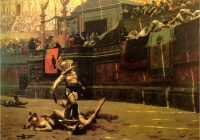Group
From The Art and Popular Culture Encyclopedia
(Difference between revisions)
| Revision as of 15:25, 24 March 2013 Jahsonic (Talk | contribs) ← Previous diff |
Revision as of 15:26, 24 March 2013 Jahsonic (Talk | contribs) Next diff → |
||
| Line 1: | Line 1: | ||
| - | [[Image:Inversions.jpg|thumb|right|200px|''[[Inversions]]'', the first French [[gay]] journal is published. Produced between [[1924]] and [[1926]]. [[Homosexual]]s, [[African-American]]s, [[women]], to name but a few, have always been [[social group]]s who have felt [[alien]] to the [[mainstream]].]] | + | [[Image:Jean-Leon Gerome Pollice Verso.jpg|thumb|right|200px|''[[Pollice Verso]]'' by Jean-Léon Gérôme, 1872, is the immediate source of the "[[thumbs down]]" [[gesture]] in [[popular culture]]. It is owned by [[Phoenix Art Museum]].]] |
| {{Template}} | {{Template}} | ||
| In [[sociology]], a '''group''' is usually defined as a collection of [[human]]s or [[animal]]s, who share certain characteristics, interact with one another, accept expectations and obligations as members of the group, and share a common [[Identity (social science)|identity]]. Using this definition, [[society]] can appear as a large group. | In [[sociology]], a '''group''' is usually defined as a collection of [[human]]s or [[animal]]s, who share certain characteristics, interact with one another, accept expectations and obligations as members of the group, and share a common [[Identity (social science)|identity]]. Using this definition, [[society]] can appear as a large group. | ||
Revision as of 15:26, 24 March 2013

Pollice Verso by Jean-Léon Gérôme, 1872, is the immediate source of the "thumbs down" gesture in popular culture. It is owned by Phoenix Art Museum.
|
Related e |
|
Featured: |
In sociology, a group is usually defined as a collection of humans or animals, who share certain characteristics, interact with one another, accept expectations and obligations as members of the group, and share a common identity. Using this definition, society can appear as a large group.
While an aggregate comprises merely a number of individuals, a group in sociology exhibits cohesiveness to a larger degree. Characteristics that members in the group may share include interests, values, ethnic/linguistic background, and kinship ties.
Contents |
See
A group is a number of things or persons being in some relation to one another.
Mathematics
- Group (mathematics), a set together with a binary operation satisfying certain algebraic conditions
- Group theory, the study of groups
- Group action, a way of describing the symmetries of objects using groups
- Group isomorphism, a one-to-one correspondence (function) between two groups which respects the given group operations
- Group object, a kind of generalization of a group which is built on more complicated structures than sets
Science
Chemistry
- Functional group, a functional entity consisting of certain atoms whose presence provides a certain property to a molecule
- Group (periodic table), a column in the periodic table of chemical elements
Biology
- Cultivar group, a formal classification category in the International Code of Nomenclature for Cultivated Plants (ICNCP)
- Group selection, in evolutionary biology, the idea that alleles can become fixed or spread in a population because of the benefits they bestow upon groups of organisms
Cosmology
- Galaxy groups and clusters, a small number of galaxies near each other
- Local Group, the group containing the Milky Way Galaxy
Other
- Group delay and phase delay
- a set of lenses stacked together
- Group (stratigraphy), in geology, a lithostratigraphical unit; a group consists of formations, or rock strata
Business
- Business group, a legal entity comprising several companies
Sociology
- Social groups, a description of various human groups
- Group action (sociology)
- Group affective tone
- Group attribution error
- Group behaviour
- Group cohesiveness
- Group conflict
- Group development
- Group dynamics
- Group polarization
- Group-serving bias
- Group sex
Identity groups (limited list)
- Identity group
- Friend
- Enemy
- Secular group also called secular organization
- Religious group
- Affiliation
- Cult
- Sect
- Ethnic group
- Nationality
- Insider
- Cultural group
- Mainstream
- Subculture
- Gang
- Native
- Immigrant
- Clan
- Family
- Fan
- Supporter
- Opposition
Computing and the Internet
- Group (computing), a collection of users or other objects
- Group editor, a program that allows many people to edit a shared document over a computer network
- Usenet newsgroup
- Google Groups
- Yahoo! Groups
- Facebook groups
Military
- Army group
- Group (air force), an air force formation
- Group Captain
Other uses
- Breed Groups (dog), the group or category to which breeds of dogs are assigned by kennel clubs
- Group (auto racing), a category of car allowed to compete in auto racing.
- Group insurance covering people with common characteristics
- A musical ensemble:
Other labels used to describe groups
See also
See also
Unless indicated otherwise, the text in this article is either based on Wikipedia article "Group" or another language Wikipedia page thereof used under the terms of the GNU Free Documentation License; or on research by Jahsonic and friends. See Art and Popular Culture's copyright notice.

